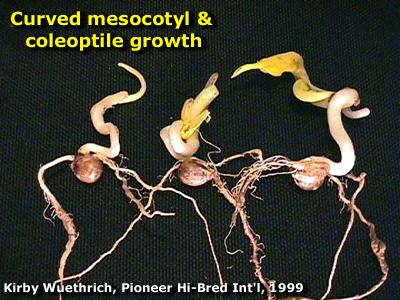
![]() ore than one report of incomplete corn emergence has
been received with accompanying descriptions of mesocotyls and coleoptiles that
are twisted, corkscrewed, spiraling, and otherwise 'messed up' below the soil
surface. The end result of such spiraling sub-surface seedlings is either
underground leaf emergence or eventual death of the seedling. As is usual with
crop problems, several culprits can cause this symptom and afflicted growers
need to identify which is the most likely cause in their situation.
ore than one report of incomplete corn emergence has
been received with accompanying descriptions of mesocotyls and coleoptiles that
are twisted, corkscrewed, spiraling, and otherwise 'messed up' below the soil
surface. The end result of such spiraling sub-surface seedlings is either
underground leaf emergence or eventual death of the seedling. As is usual with
crop problems, several culprits can cause this symptom and afflicted growers
need to identify which is the most likely cause in their situation.
Kernel Position in Furrow: The position of the kernel in the furrow with respect to the embryo face directly influences initial location where the plumule emerges. The plumule, which later differentiates into the mesocotyl and coleoptile, emerges from the embryo side of the kernel, initially elongating toward the dent end of the kernel. If the kernel lands embryo face down in the furrow, the plumule emerges on the bottom side of the kernel, elongates horizontally until the mesocotyl 'clears' the end of the kernel, then finally begins its upward ascent.

Restricted Emergence: Corkscrewed mesocotyl/coleoptile development often results when the coleoptile encounters resistance as the mesocotyl elongates. Such resistance can be caused by severe soil crusting, a naturally dense soil surface, or cloddy soil surfaces. A combination of severe sidewall compaction plus press wheel compaction over the furrow can also restrict coleoptile emergence.
Herbicide Injury: Certain herbicides, notably cell growth inhibitors, can affect seedling shoot development especially if weather or soil conditions are not conducive for rapid growth. Quite often when herbicide is part of the blame, significant soil crusting is also a major factor.
Temperature Response: Some years ago, I came across an article from Rhodesia (Buckle & Grant. 1974. Rhod. J. Agric. Res. 12: 149-161) that described the same phenomenon and attributed it to large fluctuations between day and night soil temperatures. Abnormal mesocotyl and/or coleoptile development occurred most frequently when soil temperatures fluctuated from daytime highs of about 80 degrees F to nighttime lows of about 55 degrees F. The data also suggested that extended periods of cold temperatures stunted and distorted seedling growth.
